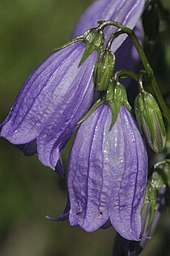Lawn Bellflower
| Lawn Bellflower | ||||||||||||
|---|---|---|---|---|---|---|---|---|---|---|---|---|

Lawn Bellflower ( Campanula cespitosa ) |
||||||||||||
| Systematics | ||||||||||||
|
||||||||||||
| Scientific name | ||||||||||||
| Campanula cespitosa | ||||||||||||
| Scop. |
The lawn bellflower ( Campanula cespitosa ) is a species of bellflower ( Campanula ) within the family of the bellflower family (Campanulaceae).
description
Vegetative characteristics
The lawn bellflower grows as a perennial herbaceous plant and reaches heights of 10 to 20, rarely up to 30 centimeters. The stem leaves are densely packed in the lower part of the stem.
Generative characteristics
The flowering period ranges from rarely July, mostly August to September. Rarely only one, usually 3 to 15 nodding flowers are in a usually somewhat one-sided inflorescence . The hermaphrodite flowers are five-fold with a double flower envelope . There are no appendages between the calyx tips. The five light blue petals are fused together like a bell. The 10 to 15, rarely up to 18 millimeters long crown has delicate, somewhat darker longitudinal nerves, three of which each run into a crown tip. The corolla lobes incline outward and the corolla tube is slightly narrowed below the calyx lobes. The anthers are about as long as the stamens and are free from each other during flowering.
The number of chromosomes is 2n = 34.
Occurrence
The distribution area of the lawn bellflower extends from north-western Italy (only in the regions Trentino-South Tyrol , Veneto , Friuli-Venezia Giulia ) and Austria to Slovenia and north-western Croatia . In Austria it occurs frequently to scattered in Lower Austria , Upper Austria , Styria and Carinthia .
In the Alps it thrives in the montane to subalpine altitude range . The lawn bellflower can only be found above fresh, calcareous soil or on dolomite . The lawn bellflower usually prefers rock and debris corridors as a location; they are often found in pine forests. It is a species of the class Thlaspietea rotundifolii.
Common names
The name Glöggli is also used as a common name for the St. Gallen area near Werdenberg .
literature
- Wolfgang Adler, Karl Oswald, Raimund Fischer: Excursion flora of Austria. Ed .: Manfred A. Fischer . Ulmer, Stuttgart / Vienna 1994, ISBN 3-8001-3461-6 .
- Schmeil, O. & Fitschen, J. 2011: The flora of Germany and neighboring countries , 95th edition. Quelle & Meyer Verlag, Wiebelsheim.
Individual evidence
- ↑ a b Erich Oberdorfer : Plant-sociological excursion flora for Germany and neighboring areas . With the collaboration of Angelika Schwabe and Theo Müller. 8th, heavily revised and expanded edition. Eugen Ulmer, Stuttgart (Hohenheim) 2001, ISBN 3-8001-3131-5 , pp. 893 .
- ↑ Data sheet distributed in Italy and photos from Flora Italiana at Schede die Botanica .
- ↑ Rafaël Govaerts (Ed.): Campanula cespitosa - data sheet at World Checklist of Selected Plant Families of the Board of Trustees of the Royal Botanic Gardens, Kew. Last accessed on April 6, 2016.
- ^ Georg August Pritzel , Carl Jessen : The German folk names of plants. New contribution to the German linguistic treasure. Philipp Cohen, Hannover 1882, page 75. ( online ).

